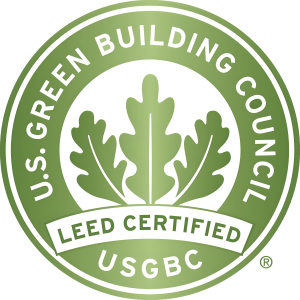Top 10 reasons to certify to LEED
Take a look at our top reasons to invest in LEED certification.
As we count down to our top 10 states for LEED in 2021 announcement, we are taking a look at the top 10 reasons to certify to LEED.
- Reduced energy use and carbon emissions: A University of California–Berkeley study found that LEED-certified existing buildings contributed 50% fewer greenhouse gases (GHGs) than conventionally constructed buildings due to water consumption, 48% fewer GHGs due to solid waste and 5% fewer GHGs due to transportation.
- Accountability: USGBC stands for accountability through the LEED third-party certification process. The LEED plaque stands for leadership and demonstrates that a building has been designed and built, and is operating, as intended. Being “built to LEED” or “LEED equivalency” doesn’t exist—there is no substitute for LEED certification.
- Higher resale value and faster lease-up rates: A recent report from USGBC member Cushman and Wakefield analyzed LEED-certified buildings delivered between 2010 and 2020 and found that these properties were consistently more profitable than noncertified spaces in terms of rent (11% higher during the most recent five years) and reduced vacancy.
- Lower utility costs: LEED buildings use, on average, 25% less energy than conventional buildings. In fact, the average Energy Star score of a LEED-certified building is 89.
- Less waste: By 2030, LEED projects will have diverted more than 540 million tons of waste from landfills. For projects that want to dig deeper into waste reduction, the TRUE zero waste program is also available.
- Improved employee retention: LEED-certified buildings can help companies attract talented employees. Plus, with strategies focused on thermal comfort and access to daylight, views and good indoor air quality, worker satisfaction in LEED-certified offices tends to be high, decreasing employee turnover. This is especially true among younger workers, who place a high value on working for employers that are green-minded and “walk the walk.”
- Ability to meet ESG goals: LEED helps investors meet their ESG goals by providing them with a robust and globally recognized green building framework to measure and manage their real estate performance. The 2021 Cushman and Wakefield study found that the COVID-19 pandemic created an increase in tenant demand for spaces that met ESG goals, and LEED-certified assets have had lower vacancy rates than their conventional counterparts since the pandemic began. The 10-year time span of buildings covered in the study also suggested to the analysts that LEED spaces are more resilient overall during periods of market downturn or following a recession.
- Tax benefits: Depending on where you are, LEED certification may qualify for tax breaks. USGBC has partnered with IncentiFind, which can help you find money for your LEED projects! In some cases, LEED buildings are located in special economic growth zones that can even mean paying little to nothing in state or local taxes.
- Solid data on asset performance: LEED measures operating performance through the LEED for Existing Buildings: Operations and Maintenance rating system, which provides a road map for property managers, portfolio owners and service providers to verify the ongoing energy, water, carbon, waste and human experience performance of their buildings.
- Knowing LEED works: More than 100,000 projects are using LEED to meet their goals, counting on its proven track record and third party verification. Be a part of the growing global green building community.



